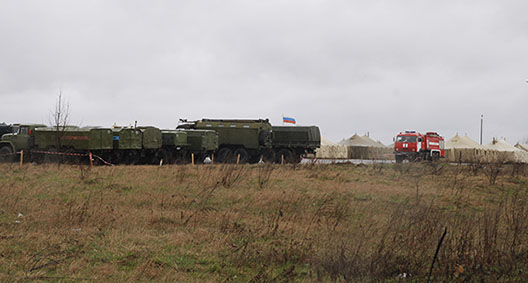 Less than a month after Russia’s annexation of Crimea, a further Russian incursion into eastern Ukraine remains a distinct possibility. President Vladimir Putin may be emboldened by the weakness of the central government in Kyiv and a failure so far of Western sanctions to enforce painful to consequences on Russia. Putin has had an invasion force assembled on Ukraine’s eastern border for nearly a month, and he may feel that he has sufficiently set the stage for an invasion with the seizure by armed, pro-Russian demonstrators of government buildings in three Ukrainian provinces. After all, that was the method used only weeks ago in Russia’s successful occupation of Crimea.
Less than a month after Russia’s annexation of Crimea, a further Russian incursion into eastern Ukraine remains a distinct possibility. President Vladimir Putin may be emboldened by the weakness of the central government in Kyiv and a failure so far of Western sanctions to enforce painful to consequences on Russia. Putin has had an invasion force assembled on Ukraine’s eastern border for nearly a month, and he may feel that he has sufficiently set the stage for an invasion with the seizure by armed, pro-Russian demonstrators of government buildings in three Ukrainian provinces. After all, that was the method used only weeks ago in Russia’s successful occupation of Crimea.
What type of an incursion might Russia make? A broad or a more limited invasion? Igor Sutyagin and Michael Clarke, scholars at the Royal United Services Institute, paint four possible scenarios:
|
- Russian troops on Ukraine’s border may be merely a threatening rattle of the Russian sabre. Russia has gotten Crimea and this military escalation is a way of forcing Ukraine to accept the new reality. This scenario is not very probable, Sutyagin and Clarke write, because Russian Interior Ministry troops have been put on high alert, suggesting that Moscow expects action along the border region.
- Russia may engineer civil unrest throughout southeastern Ukraine and use that as a pretext for opening a “secure land corridor to Crimea” from Russia, through Donetsk, Zaporizhzhia and Kherson provinces.
- Using separatist turmoil and a subsequent invasion, Russia might split Ukraine in two, seizing the entire country east of the Dnipro (Dnieper) River.
- Russia may seize southwestern Ukraine to create a separate, strategic land corridor between its occupation force in Crimea and its troops in the Moldovan enclave of Transnistria. This would include Kherson, Odessa and Mykolayiv provinces, as well as the seaport, Odessa.
Sutyagin and Clarke say Russia’s choice will rely on how it assesses the value of key resources in the Ukrainian provinces it could target. These include oil and gas fields, rich, food-producing farmlands, and strategically important arms factories.
With the annexation of Crimea, Russia’s state-controlled energy giant, Gazprom, has declared control of Ukraine’s offshore gas and oil fields in the Sea of Azov. If Russia seizes the eastern land corridor to Crimea, it would cut Ukraine off from that coastline, consolidating that claim.
That eastern corridor would help Russia supply Crimea by land, meeting its heavy dependency on basics such as food, 85 percent of which must come from the Ukrainian mainland.
While military imports from Ukraine are not particularly extensive, they are vital for strategic sectors of Russia’s defense complex and cannot immediately be replaced by Russian production. These imports include intercontinental ballistic missiles, missile guidance systems, gas turbine engines and gears, air force missiles and auxiliary systems as well as medium range air-to-air missiles. Ukraine also supplies natural uranium for Russia’s nuclear industry.
This Russian reliance on Ukraine’s defense industry may might increase Russia’s incentive to find a peaceful resolution in the Ukraine-Russia relationship, or, in light of recent events, propel Putin to grab these enterprises as part of a larger land grab.
May will be the critical month for Russia’s decision-making, say Sutyagin and Clarke. Ukrainian presidential elections are to take place on May 25. If they go well, that will diminish Putin’s claims to be acting in the humanitarian interests of Russian speakers living in Ukraine. Furthermore, come May Russian troops, which have been at readiness for nearly a month will be losing their combat effectiveness. Troops must either be deployed or stand down.
Irena Chalupa covers Ukraine and Eastern Europe at the Atlantic Council.
Image: Military tents and trucks are seen in a field near the village of Valuyki, in the Belgorod region, near the border with Ukraine, April 10, 2014. REUTERS/Anton Zverev

